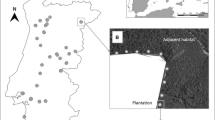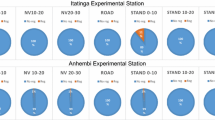Abstract
Eucalyptus species are the native and major plant group in Australian landscapes. Since European settlement, eucalypt trees heavily decline in the tablelands of New South Wales. Tree recruitment bog down and the landscape ecosystem hardly recovers to the original state. This paper introduces the history of eucalypt trees and native shrubs decline, analyzes reasons of seedling recruitment decrease in this region, such as clearing grazing, fire, competition from exotic species, dieback, insects, drought and so on, and summarizes the probable conditions of eucalypt tree recruitment, such as suitable conditions of seedling survival, sufficient seed supply, keep from predation, suitable germination conditions, non-grazed environment, mechanical treatment, weed control, fire regime, disease control etc, lending suggests how to preserve and encourage eucalypt trees recruitment in the area.
Similar content being viewed by others
References
Anderson, R.H. 1956 The Trees of New South Wales [M]. Sydney: A. H. Pettifer, Government Printer.
Allen, R.J. 1983 Tree decline in western New South Wales: fact or fiction [J]? Australian Forestry,46(4): 303–310.
Charman, P.E.V. and Murphy, B.W. 1991. Soils-their properties and management [C]. In: A Soil Conservation Handbook for New South Wales. Sydney: Sydney University Press.
Clarke, P.J. 2000. Plant population processes in temperate woodlands of eastern Australia—premises for management. Temperate eucalypt woodlands in Australia, biology, conservation, management and restoration [C]. New South Wales: Surrey Beatty & Sons, Pp. 298–317.
Cremer, K.W. 1990. Trees for rural Australia. CSIRO division of forestry and forest products [M]. Camberra: Inkata Press.
Curtis, D. and Reeve, I. 1988. Growback in Victoria—Community responses to tree decline [M]. Armidale: Armidale tree group Publ.
Curtis, D. 1989. Eucalypt re-establishment on the northern tablelands of New South Wales [D]. New South Wales: A thesis submitted for the degree of Master of Science of the University of New England, Armidale.
Florence, R.G. 1996. Ecology and silviculture of Eucalypt forests [M]. CSIRO Publishing House.
Hodgkinson, K.C. 1979. The shrubs of poplar box (Eucalyptus populnea) lands and their biology [J]. Australian Rangeland Journal, 1: 280–293.
Landsberg, J. 1990. Dieback of rural eucalypts: does insect herbivore relate to dietary quality of tree foliage [J]? Australia Journal of ecology,15: 73–87.
Lawrence, J., Semple, W.S. and Koen, T.B. 1998. Experimental attempts at encouraging eucalypt regeneration in non-native pastures of Northern Victoria and Central Western NSW [C]. In: Eucalypt regeneration in pastures. Proc. Linn. Soc. New South Wales.
Leigh, J.H. and Holgate, M.D. 1979. The responses of the understorey of forests and woodlands of the south tablelands to grazing and burning [J]. Australian Journal of Ecology,4: 25–45.
Noble, J. C., Tongway, D.J., Rober, M.M. and Whitford, W.G. 1996. Fire studies in mallee (Eucalyptus spp.) communities of Western New South Wales: spatial and temporal fluxes in soil chemistry and soil biology following prescribed fire [J]. Pacific Conservation Biology,2, 398–413.
Reid, N. and Landsberg, J. 2000. Tree decline in agricultural landscapes: What we stand to lose [C]. Temperate eucalypt woodlands in Australia, biology, conservation, management and restoration. New South Wales: Surrey Beatty & Sons. Pp. 298–317.
Schabel, J. and Eldridge, D.J. 2001. A comparison of roadside and paddock vegetation in the box woodlands of Eastern Australia [R]. Occasional Paper No. 7 school of Geography, The University of New South Wales. A technical report prepared for the central west catchment management board, New South Wales.
Semple, W.S. 1997. Eucalypt regeneration in white box (Eucalyptus Albens Benth.) communities [D]. A thesis submitted in partial fulfillment of the requirements for the degree of master of letters (plant biology) at the University of New England, Armidale, NSW.
Semple, W.S. 1997. Native and naturalized shrubs of the bathurst granites: past and present [J]. Gunninghamia,5(1): 4, 9–80.
Semple, W.S. and Koen, T.B. 1997. Effect of seedbed on emergence and establishment from surface sown and direct drilled seed ofEucalyptus spp. andDodonare Viscosa [J]. Rangeland Journal,19(1): 80–94.
Venning, J. 1988. Growing trees for farms, parks and roadsides: a revegetation manual [M]. Melbourne: Lothian Publishing Company Pty Ltd.
Walker, D. and Singh, G. 1981. Vegetation history [C]. In: Australian vegetation, Greves, R.H. Eds. Cambridge: Cambridge University Press, p26–44.
Williams, R.J. and Ashton, D.H. 1987. Effects of disturbance and grazing by cattle on the dynamics of healthland and grassland communities on the Bogoing High Plains, Victoria [J]. Australian Journal Botany,35: 413–431.
Williams, J.E., Whelan, R.J. and Gill, A.M. 1994. Fire and environmental heterogeneity in southern temperate forest ecosystems: implications for management [J]. Australian Journal of Botany,42: 125–137.
Windsor, D.M. 2000. A review of factors affecting regeneration of box woodlands in the central tablelands of New South Wales. Temperate Eucalypt woodlands in Australia, Biology, Conservation, Management and Restoration [C]. New South Wales: Surrey Beatty & Sons. Pp.271–285.
Windsor, D.M., Clements, A., Nolan, M.B. and Sandercock, H. 2000. Recreating eucalypt woodland with a grassy understorey on a gold mine in the central tablelands of New South Wales [C]. In: Temperate Eucalypt Woodlands in Australia, Biology, Conservation, Management and Restoration. New South Wales: Surrey Beatty & Sons. Pp.298–317.
Yates, C.J., Hobbs, R.J. and Bell, R.W. 1996. Factors limiting the recruitment ofEucalyptus salmonophloia in remnant woodlands. III. Conditions necessary for seed germination [J]. Australian Journal Botany,44: 283–296.
Yates, C.J. and Hobbs, R.J. 2000. Temperate eucalypt woodlands in Australia an overview. Temperate Eucalypt woodlands in Australia; Biology, Conservation, Management and Restoration [C]. New South Wales: Surrey Beatty & Sons. Pp. 1–5.
Author information
Authors and Affiliations
Additional information
Foundation item: This study was supported by CSC (Chinese Scholarship Communi), CSIRO and Australia-China Council.
Biography: Zhang Yan-hua (1967-), female, Ph. D., associate professor Shaoxing College of Arts and Sciences, Shaoxing 312000, P. R. China
Responsible editor: Song Funan
Rights and permissions
About this article
Cite this article
Yan-hua, Z., Li-fu, S. & Hodgkinson, K.C. Decline of eucalypt trees in tablelands of New South Wales, Australia. Journal of Forestry Research 16, 306–310 (2005). https://doi.org/10.1007/BF02858197
Received:
Accepted:
Issue Date:
DOI: https://doi.org/10.1007/BF02858197




